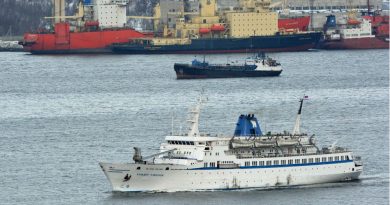How the North is doing when it comes to Canada’s climate targets

Transportation sector biggest source of greenhouse gases in all 3 territories, says report author
The North accounts for a “very small fraction” of Canada’s total greenhouse gas emissions, but a new climate change report says the territories should still be setting more ambitious reduction targets.
The report by the Pembina Institute, an energy and climate-think tank, says Canada is not on track to achieve its recently announced 2030 or 2050 net-zero goals — and success requires an “all hands on deck” approach from all levels of government.
“Unfortunately, if we look at the policy infrastructure in place, there are some important gaps in terms of climate planning and adaptation in the North,” said Isabelle Turcotte, Pembina’s director of federal policy.
The hope, she said, is not to “point a finger” at the territories — which face a unique set of challenges and impacts compared to the provinces — but to encourage collaboration between all levels of government so Canada meets its targets and the North receives support in mitigating and adapting to climate change.
Turcotte’s suggestion for each territory — in broad strokes — is to transition from diesel fuel to clean energy, to empower remote communities to produce their own renewable energy and to build energy-efficient housing.
Action plan needed in Nunavut
Nunavut’s last climate change plan was from 2003, and it’s the territory with the biggest opportunity for change, said Turcotte.
“A priority recommendation for Nunavut is to develop a new climate plan, as well as an adaptation plan, to make sure that those impacts of climate change are understood,” she explained.

The report says the territory accounts for only 0.1 per cent of Canada’s greenhouse gas emissions, but those emissions have increased by 25 per cent since 2005 and are projected to continue growing.
“Nunavut faces many pressing challenges in terms of meeting health, housing and education needs,” the report reads. But Turcotte said there are “synergies” between initiatives that would address these issues while also reducing emissions.
“Along with renewable energy projects, the government of Nunavut in partnership with the Nunavut Housing Corporation should develop more energy efficiency and conservation programs … and make building retrofits a priority,” said the report.
N.W.T. ‘lacks concrete policies’
The Northwest Territories, meanwhile, has “some leadership” for its goal to reduce greenhouse gas emissions by 30 per cent of what they were in 2005 by 2030 said the report.
However, the plan “lacks concrete policies to show how it’ll reach” its goals, said Turcotte.
“What we’re recommending across the board is for government, including in the North, to set higher 2030 targets and break that down into sectoral targets,” she explained.
Like the rest of the North, the N.W.T. makes up a very small portion of Canada’s total greenhouse gas emissions — 0.2 per cent.
Despite not having a strategy to address climate change until 2018, the report said that greenhouse gas emissions in the territory have decreased by 16 per cent since 2005 and are projected to decrease by another 4 per cent by 2030.
The N.W.T.’s target also falls short of Canada’s new target — the federal government said it was aiming for a 40 to 45 per cent reduction in greenhouse gas emissions by 2030 earlier this month.
Turcotte said the N.W.T. has no target for 2050.
Yukon a leader in climate action
Yukon, on the other hand, has targets for both 2030 and 2050.
The territory recently bumped its emission reduction target to 45 per cent, to match the federal target, in what Turcotte calls a “display of leadership” and a “win for the territory.”
Yukon’s climate action plan, reads the report, has “concrete actions to reduce emissions across the economy, including its highest emitting sectors.”
Turcotte said there are opportunities for Yukon to do more.
“Namely, by increasing that climate target and focusing again on access to clean energy and energy efficiency.”
Emissions from Yukon account for 0.1 per cent of Canada’s overall greenhouse gas emissions.
Transportation
The transportation sector is the biggest creator of greenhouse gas emissions in all three territories — in 2019, it made up 75 per cent of the Yukon’s emissions, 68 per cent of Nunavut’s and 58 per cent in the Northwest Territories.
Turcotte said traditional solutions — like public or active transportation — or electric vehicles aren’t as easy to implement in the North because of its low population density and broad geographical scale.
Nonetheless, electric vehicles could be a long term solution, she said.
“There are opportunities to increase the availability of electric vehicles in the North and I think tackling what the specific barriers to uptake would be, identifying and tackling them, is an important first step.”
Turcotte said a transition to biodiesel and renewable natural gas is also an option — which would allow people to continue using the vehicles they have but would reduce the intensity of the fuels being used.
The goal of the report, she said, is to show Canadians the federal government can only do so much when it comes to climate change because provinces and territories have jurisdiction over the energy sector.
“This report highlights there are major deficiencies and major gaps … it should strongly suggest to Canadians and ring an alarm bell that their governments aren’t planning for their long-term well being,” said Turcotte.
Related stories from around the North:
Canada: Arctic climate change among priorities of Canada’s new Governor General, Eye on the Arctic
Greenland: Tipping points: can a leaked report tip the scales to climate action? Blog by Irene Quaile
Norway: Polar bears face extinction in Svalbard and Arctic Russia says scientist, The Independent Barents Observer
Russia: Record breaking temperatures recorded in Arctic Russia, Eye on the Arctic
Sweden: Heavier rainfall will increase risk of landslides and flooding in Sweden, Radio Sweden
United States: Alaska’s Northwest Arctic Borough gets $2 million tribal energy grant, Alaska Public Media



